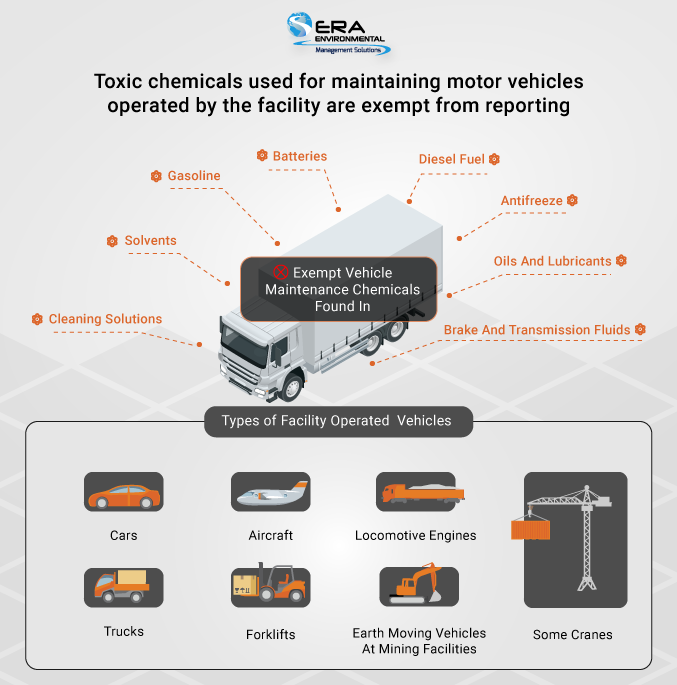Finding out that some of the practices at your facility are exempt from TRI reporting is a major relief for any reporter, yet the process of navigating the intricacies of each exemption can prove to be a challenge. Following ERA’s TRI reporting webinar, it was evident that many attendees had misconceptions about the TRI motor vehicle exemption.
Former TRI coordinator Nora Lopez answered many questions on the vehicle exemption and provided EPA resources to help you investigate this further. In this article, ERA will break down this rule and list a couple of examples from the EPA to help you determine if the exemption applies to you.
What is the TRI Vehicle Exemption?
The regulation addresses EPCRA 313 (TRI) chemicals that are used to maintain motor vehicles at your facility. It states:
The use of products containing toxic chemicals for the purpose of maintaining motor vehicles operated by the facility is exempt from threshold determinations and waste management calculations.
40 CFR Section 372.38(c)(4).
It may seem straightforward, but often facilities are unclear as to what constitutes "vehicle maintenance activities.” These activities vary according to the type of vehicle; maintenance for a plane differs from that of a forklift or a crane. EH&S professionals often need clarity on what needs to be reported and what doesn’t, as evidenced by the questions posed during ERA’s TRI reporting webinar.
Sample Vehicle Exemption Questions
Can you explain what TRI covers regarding vehicles and fuel reporting?
Does the rule only apply to on-site vehicles, or does it cover plant-to-plant fuel usage?
Which TRI Threshold Activities Apply to the Vehicle Exemption?
This EPA automotive regulation applies only to the 'otherwise use' TRI activity category and does not apply to the processing or manufacturing of toxic chemicals, for example, the production of combustion byproducts. ‘Otherwise use’ activities include the maintenance of vehicles operated by your facility and are listed in the diagram below.
Maintenance Chemicals & Types of Vehicles included in the TRI Motor Vehicle Exemption
Manufacturing activities are not included in the exemption and therefore manufacture of combustion byproducts that maybe TRI chemicals are not exempted and should be included in your threshold and releases calculation.
As stated earlier, processing activities are also not exempted and should be reported. The EPA’s example is that of a vehicle manufacturer using a toxic chemical in their operations, such as adding transmission fluids with a listed TRI chemical in vehicles before they are shipped for sale. This falls under processing because the fluid is incorporated into a commercially distributed product.
Only ‘otherwise use’ activities fall under the vehicle exemption. Releases from fuel storage for use by company or facility-owned vehicles (including toxic chemicals in gasoline stored on-site) or motor vehicle maintenance products for facility vehicles do not need to be included in release and waste management reporting.
The Motor Vehicle Use Exemption Does Not Apply to Stationary Equipment, for example, the use of lubricants for stationary process equipment such as pumps or compressors. Likewise, fuels used for furnaces, boilers, heaters, or any stationary source of energy are not exempt.
What if the Facility Stores Fuel for Use by Both on-site Vehicles and Vehicles in Other Facilities?
If your company owns many TRI reporting facilities but stores gasoline at only one of them, the exemption only applies the motor vehicles stationed at the facility that stores the gasoline. The EPA addressed this technicality by pointing out that if the fuel is used by trucks being sent to other locations and facilities, the storage falls under processing activities, making it subject to TRI Reporting. Off-site truck gasoline re-fueling usage would not be exempted. If you have an offsite truck that is fueled off-site, they may be eligible for the exemption for the toxic chemical in the gasoline otherwise used on-site.
The same rule also applies to using jet fuel to refuel planes. If the fuel is used solely for the purpose of moving planes within the facility, then it is exempt from reporting. However, if you are using the jet fuel to fill planes that will leave your site to be sold or used commercially, then this activity falls under processing and should be reported.
Should I Report Chemicals Used to Maintain Rail Cars or Tractor-Trailers That Have No Motors?
The paint and lubricants used to maintain railcars and tractor-trailers should be factored into threshold determinations and reported for TRI because they are not motor vehicles. This applies to any company equipment with no motor, including barges and dredging equipment.
What If I am Using a Chemical to Deice My Vehicles?
Aerospace facilities use ethylene glycol to deice the wings of their aircraft. As this activity is an aircraft maintenance practice, it falls under the exemption. You can skip the threshold determination and recording for it.
Deicing seems like an apparent maintenance activity, but it becomes complicated when the chemical is used for more than that function in the facility. For example, many companies use methanol as windshield wiper antifreeze for vehicles on-site but additionally use it as a part of a product that is processed. This means that only the methanol used as antifreeze should be excluded in your calculation, whereas the latter should be included.
Automating EPA Exemption Determinations
Many facilities are choosing to automate their TRI reporting process. Having software that accounts for all the above-stated nuances is the best way to ensure that you don’t miss a reportable chemical. ERA’s TRI reporting software handles your threshold determination and automatically omits chemicals and activities that do not need to be reported, sparing you the headache of combing through EPA FAQs for a clear answer to your specific situation.
In addition, to handling threshold determination and exemptions, ERA provides superior QA/QC capabilities for your data and generates a CDX upload-ready file for you, alleviating the reporting burden. ERA scientists also diligently check TRI regulations and update the platform in case of chemical and activity-related changes saving your EH&S department the hassle of finding out what each TRI update means for your facility.
To learn more about this simple approach to TRI reporting, schedule a consultation call with a project analyst below.
References
- Environmental Protection Agency. (n.d.). Toxics Release Inventory (TRI) Guideme. EPA. Retrieved June 9, 2022, from https://ordspub.epa.gov/ords/guideme_ext/f?p=guideme%3Agd-list
- Environmental Protection Agency. (n.d.). Toxics Release Inventory (TRI) Guideme. EPA. Retrieved June 9, 2022, from https://ordspub.epa.gov/ords/guideme_ext/f?p=guideme%3Aqa-search%3A%3A%3A%3ARP%3AIRC_KEYWORD%3AMotor+Vehicle+Exemption


Comments